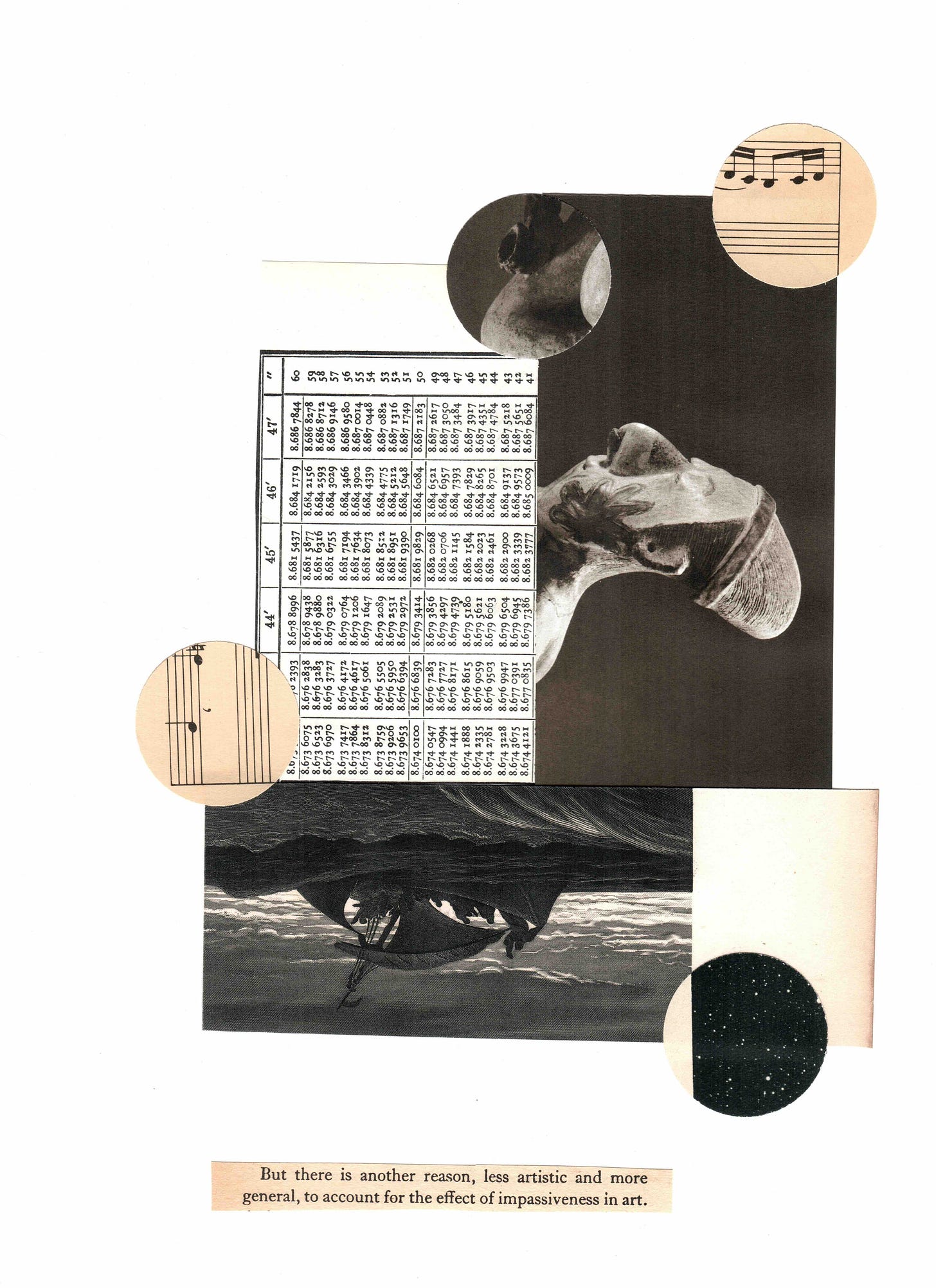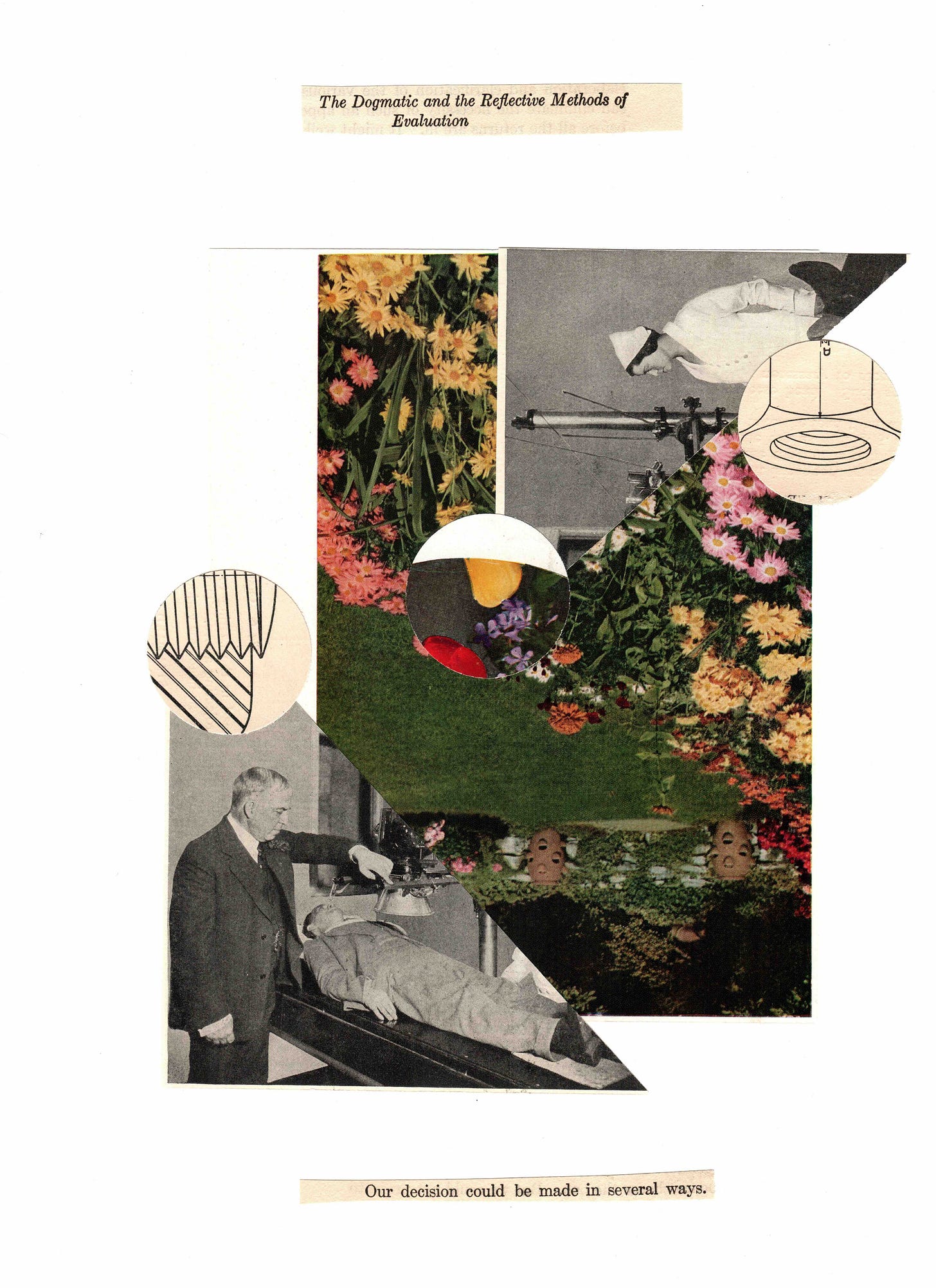41 Iluminaciones para armar (en tres partes)-fragmentos
41 Illuminations (an Assembly Kit in Three Parts)- excerpts

I am sharing a few translated excerpts from an exhibition and publication project developed for the Instituto Cabañas in Guadalajara, Mexico, in the memory of my brother, the author Luis Ignacio Helguera. I used the format of the prose poem (a medium he favored) and the chapter/title structure of the book Illuminations by Arthur Rimbaud (1886). The exhibition includes an accompanying collage for every text, as well as sculptures, video and works by invited emerging artists from Guadalajara in response to instruction art prompts I have written (in the “Workshop” section). The third and final section of the book is a series of aphorisms in the form of study questions (“Test”).
The book, which is in Spanish, has been published by Editorial Impronta in Guadalajara.
Comparto fragmentos de un proyecto de exposición y publicación desarrollado para el Instituto Cabañas de Guadalajara en memoria a mi hermano, el escritor Luis Ignacio Helguera. Utilicé el formato del poema en prosa (un género que él favorecía) así como la estructura y los títulos del libro Iluminaciones de Arthur Rimbaud (1886). La exposición incluye un collage que acompaña cada texto, así como esculturas, videos y trabajos de artistas emergentes que han sido invitados pare responder a diferentes provocaciones que he escrito ( en la sección titulada “Taller”). La tercera y última parte del libro es una serie de aforismos a manera de preguntas de studio (Examen).
El libro, cuya única y original version es en español, ha sido publicado por editorial Impronta en Guadalajara.
I. ILLUMINATIONS
2. CHILDHOOD
An evening in La Quebrada. (Note: this is a remote memory; not a real-life scene; both series of images continue being equally imperfect). It is about five or six in the afternoon, dusk nears. Families of tourists gather in the viewpoint with great expectation in order to see the divers risk their lives while jumping from the cliff. The spectacle turns even more exciting when one hears, from one side or the other the stories —one does not know if true or not— of the divers who have perished over the years while falling through those 45 heart-wrenching meters of maritime circus that only require a small price to witness from the preferential viewpoint. The boy in the family, with his green cap and black fanny pack, takes photos of these moments with his first camera; the photos are poor, barely visible images showing the blue-orange stripe of the evening’s horizon and the blurry dark silhouette of the cliff from which the divers jump. After the show, they walk down the beach where they purchase a piggy bank made from a coconut in the shape of a monkey, and also a straw mask. This mask will remain in possession of the boy for forty years, traveling to various corners of the world until one Sunday, during housecleaning, will accidentally land in the trash. The deceased boy starts dreaming one night with the lost mask and the divers. Mask collectors tend to hang their pieces in their living quarters, cohabiting with them. They speak to them as one speaks to a pet; they invent phrases, personalities, histories for them. Some of them want to emulate or inhabit them, learning to be several people. They are the gesticulators of the personalities of others. But the uncommon ones, the raros, refuse to aspire to being another. They are always themselves.
INFANCIA
Una tarde en La Quebrada. (Aclaración: esta es una memoria remota, no una escena de la vida real; ambas series de imágenes continúan siendo igualmente imperfectas). Son las cinco o seis de la tarde, comienza a pardear. Las familias de turistas se aglutinan en el mirador con gran expectación para ver a los clavadistas arriesgar su vida saltando desde el acantilado. El espectáculo se vuelve aún más emocionante al escuchar de un lado y otro las historias —no se sabe si verídicas o no— de aquellos clavadistas que han perecido a lo largo de los años al surcar aquellos 45 metros cardiacos del circo marítimo que sólo requiere un precio módico para acceder al mirador preferencial. El niño, con su visor verde y una cangurera negra con su primera cámara, sacará fotos de estos momentos, apenas visibles, que mostrarán pobres imágenes, como la franja azul y naranja del horizonte de la tarde y la borrosa mancha oscura del acantilado desde donde se precipitan los clavadistas. Después del espectáculo, caminan por la playa donde compran una alcancía de coco tallada en forma de un chango junto con una máscara de paja. Esa máscara estará en posesión del niño durante cuarenta años, viajando por varios rincones del mundo hasta que un domingo de limpieza terminará, por accidente, en la basura. El difunto niño comienza a soñar una noche con la máscara perdida y con los clavadistas. Los coleccionistas de máscaras las suelen colgar en la habitación, conviviendo habitualmente con ellas. Les hablan como se le habla a una mascota; les inventan frases, personalidades, historias. Algunos de ellos quieren emularlas o habitarlas, aprenden a ser muchas personas. Son gesticuladores de las personalidades de otros. Pero los menos, los raros, se rehúsan sin aspirar a ser otros. Siempre son ellos mismos.
23. FLOWERS
I remember what flowers used to be: the expression of the eternity of history, an encyclopedia dedicated to explain young and remote elegance. Something that, lacking humanity, was always the most human. Many years later, when I returned to my native city, I admired the flower market: its fresh rain, its stands with green and orange plastic buckets placed onto volcanic rock. One of those stands contained the memory of all the flowers from our weddings and funerals.
Today I no longer have funerals nor weddings to attend.
What kind of eternity is devised for those of us who no longer have an opportunity to buy flower arrangements?
FLORES
Recuerdo lo que eran las flores: expresión de la eternidad de la historia,
una enciclopedia dedicada a explicar la elegancia joven y, a la vez,
remota. Algo que, carente de humanidad, fue siempre lo más humano.
Muchos años después, al regresar a mi ciudad natal, admiraba el
mercado de las flores: su lluvia fresca, sus puestos con cubetas de plástico
naranjas y verdes colocadas sobre la piedra volcánica. Uno de aquellos
puestos contenía la memoria de todas las flores de nuestras bodas y
funerales.
Hoy no tengo ya funerales ni bodas a los cuales asistir.
¿Qué clase de eternidad nos depara a aquellos que no tenemos
ocasión ya para comprar arreglos?
25. SEASCAPE
I stare at a vanishing picture.
One summer day in 1937, in Thunder Hole, Maine, Uncle León painted a watercolor of the waves breaking against the rocks of the shore. I grew up looking at that picture and imagining pirate stories. The romance of the ocean, of treasure islands, oceanic storms and sea shanties praising life in open sea.
It was the first and the last painting that my father collected in his life. Uncle León died 52 years ago, my father 18.
It still hangs in the living room, in an old-fashioned frame. Exposed to the sun for years, it has almost vanished, every day becoming a mere yellowed paper.
The sea vanishes, just as my father and León. Of him all that will be left will be a blank sheet of paper, a golden frame, and, if anything, a shipwrecked anecdote, eroded by light.
MARINA
Miro un cuadro desvaneciente.
Un día de verano en 1937, en Thunder Hole, Maine, el tío León pintó
una acuarela de las olas rompiendo contra las rocas de la costa.
Crecí viendo ese cuadro e imaginando historias de piratas. El
romance del océano, de las islas del tesoro, tormentas oceánicas y
canciones laudando la vida a mar abierto.
Fue el primer y último cuadro que mi padre coleccionó en vida. El tío
León murió hace 52 años, mi padre hace 18.
Aún cuelga en la sala en un marco anticuado. Expuesto al sol durante
años, se ha desvanecido y cada día va siendo más un papel amarillento.
Al igual que mi padre y León, este mar se desvanece. De él quedará tan
solo una hoja en blanco, un marco dorado y, si acaso, una anécdota en
naufragio, erosionada por la luz.
II. TALLER/ WORKSHOP
19. CITIES
At 3am, go out to the street with a table, a chair, a lamp with a green lightbulb. Put the table on a street corner, sit down, turn on the lamp. Describe, with the greatest attention of detail, every sound that is heard at that time. Title the composition “Journalism Lesson.”
CIUDADES
A las tres de la mañana, salir a la calle con una mesa, una silla, una
lámpara con una bombilla de color verde. Colocar la mesa en la esquina
de la calle, sentarse, encender la lámpara. Describir con la mayor
precisión de detalle cada sonido que se escuche a esa hora. Titular la
composición «lección de fotoperiodismo».
22. DAWN
Organize a children’s Spring parade only with the objective of making the arrangements. Pick a Tuesday or Wednesday morning for the event. Before sunrise, decorate the street with flowers, place welcome signs, balloons, ticker tape; place a table with egg shells filled with confetti and small gifts. Invite no one to the great celebration.
LA MADRUGADA
Organizar un desfile de primavera para niños sólo con el objetivo de
hacer los preparativos. Escoger un martes o miércoles en la mañana
para el evento. Antes de despuntar el día, decorar la calle con flores,
colgar letreros de bienvenida, globos, serpentinas; colocar una mesa con
alimentos, huevos con confeti y pequeños regalos. No invitar a nadie a la
gran celebración.
24.VULGAR NOCTURNE
Procure an astroturf carpet and place it on the floor. Place a blue container full of water, which will represent a pool. At midnight place a recording device to document the incidental composition of the following hours.
NOCTURNO VULGAR
Conseguir una alfombra de pasto sintético y colocarlo en el piso.
Colocar un recipiente azul lleno de agua, el cual representará una
alberca. A las cero horas de la noche colocar una grabadora junto a ellos
para documentar la composición incidental de las siguientes horas.
25. SEASCAPE
Visit a fish market. Buy a whole fish. Bring it home and place at the center of the table. Create a shrine for it. Write its epitaph.
MARINA
Visitar una pescadería. Comprar un pescado entero. Llevarlo a la casa
y colocarlo en el centro de la mesa. Elaborarle un altar. Escribir su
epitafio.

III. TEST/ EXAMEN
5. ANTIQUITY
What aspects of domestic life become a form of protection?
What are the possible conversation topics one can initiate with a mannequin?
ANTIGUEDAD
¿Qué aspectos de la vida doméstica se convierten en una forma de
protección?
¿Cuáles son las posibles temáticas de conversación que uno puede
comenzar con un maniquí?
15. CITIES
Ask the student: at what times of their lives has a musical background become a discordant accompaniment of a particular life experience?
In what way can one mentally convince oneself that a faraway place is close?
CIUDADES
Preguntarle al estudiante: ¿en qué momentos de su vida un fondo
musical se ha convertido en el acompañamiento discordante de
una experiencia vital?
¿De qué manera puede uno convencerse mentalmente que un
lugar remoto se pueda sentir cercano?
36. DEVOTIONS
What is it that motivates us to seek an authority that will point the way to comport ourselves and live life in general?
What are the similarities between credulity and skepticism?
DEVOCIONES
¿Qué es lo que nos motiva siempre a buscar una autoridad que nos
indique la manera de comportarnos y de vivir en general?
¿Cuáles son las similitudes entre la credulidad y el escepticismo?





